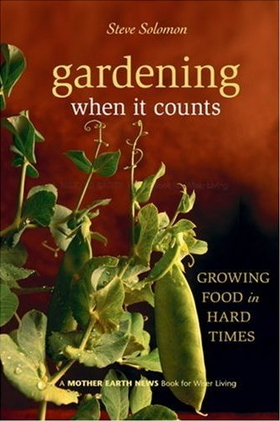
Gardening When It Counts
 Steve
Solomon's Gardening
When It Counts: Growing Food in Hard Times is the opposite of Square Foot Gardening in almost every way.
While Square
Foot Gardening is
aimed at the suburban hobby gardener, Gardening
When It Counts is
written for the serious homesteader. I complained about pages of
fluff in Square
Foot Gardening
(which Ron
rightly reminded me
was useful information for the beginning grower), but I wish Solomon
had spent twice as much space on many of the topics in his book.
Steve
Solomon's Gardening
When It Counts: Growing Food in Hard Times is the opposite of Square Foot Gardening in almost every way.
While Square
Foot Gardening is
aimed at the suburban hobby gardener, Gardening
When It Counts is
written for the serious homesteader. I complained about pages of
fluff in Square
Foot Gardening
(which Ron
rightly reminded me
was useful information for the beginning grower), but I wish Solomon
had spent twice as much space on many of the topics in his book.
I'm going to attempt to
hit the highlights of Gardening
When It Counts in
a special, two week lunchtime series, but like my series on Growing Gourmet and Medicinal
Mushrooms and
Edible
Forest Gardens,
I highly recommend that you check the book out of your local library
and read it from cover to cover. Twice. If I'd read Gardening
When It Counts
two years ago, I would have saved myself a solid year of
experimentation. You can save that year!
This post is part of our Gardening When It Counts lunchtime series.
Read all of the entries:
|
Want more in-depth information? Browse through our books.
Or explore more posts by date or by subject.
About us: Anna Hess and Mark Hamilton spent over a decade living self-sufficiently in the mountains of Virginia before moving north to start over from scratch in the foothills of Ohio. They've experimented with permaculture, no-till gardening, trailersteading, home-based microbusinesses and much more, writing about their adventures in both blogs and books.
Want to be notified when new comments are posted on this page? Click on the RSS button after you add a comment to subscribe to the comment feed, or simply check the box beside "email replies to me" while writing your comment.

I have this book and was disappointed to find Solomon's disparagement of the urban gardener in the first few pages. For homesteaders, no doubt this book is fantastic but for those of us in the city, Lee Reich's Weedless Gardening and Rosalind Creasy's books are a better bet.
You can read my Amazon review of Solomon's book here: http://www.amazon.com/gp/cdp/member-reviews/A2MTIRX7C6CAEB/ref=cm_pdp_rev_title_2?ie=UTF8&sort_by=MostRecentReview#R1B2UX30Q5ESS9
I agree --- Gardening In Hard Times is definitely not set up for backyard gardeners. To me, that's what makes it so powerful --- there are so many books out there already for that niche, but if you're running a larger operation, your choices come down to picking out what you can use from books like Square Foot Gardening or buying into the corporate mindset in mainstream agricultural publications.
I don't want to sound like I'm dissing urban homesteading, though. I'm thrilled that people in cities and suburbs are becoming more self-sufficient! But, you're right that urban homesteading requires different techniques, ones that often don't make much sense on my farm. Gardening in Hard Times is a perfect fit for my farm, and is definitely worth reading for people with acreage.
I'm reading this book at the moment, and really getting a lot from it.
I disagree that it has nothing for "urban homesteaders", well "suburban homesteaders" anyway. "Urban" implies even less space. It really comes down to how much space you have and what you're trying to do with it.
Gardening When It Counts is a system optimised around maximum output for minimum time and cost, where you're not particularly constrained by the growing area available. He talks on the scale of 2000 square foot (200 m2) gardens and 100 ft2 (10 m2) beds - that can easily fit in a 1/4 acre block, but not in significantly smaller properties. He lays out the gardens to minimise time spent weeding and watering, by spacing the plants out and giving ample room between rows to get a hoe in.
Square Foot Gardening is a system optimised around maximum output for minimum space, where time and cost are not so constrained. It talks on the scale of maybe 200 ft2 (20 m2) of garden space, with 16 ft2 (1.6 m2) beds. It pushes the plants as tightly together as it can, using special soil mixes in raised beds, vertical growing frames, and regular manual watering.
Even if you're space-constrained, there's a lot of good info in Gardening When It Counts about garden tools and their maintenance, seed selection, raising seedlings, fertilisers, etc. And it'll explain to you exactly what the compromises are when you grow more intensively - Square Foot Gardening didn't do a very good job of that in my opinion.
GWIC is a system that would scale up fairly well. For someone like a market gardener, who might have several hours a day to spend in their garden, it would really help them to maximise what they can produce within their available work time.